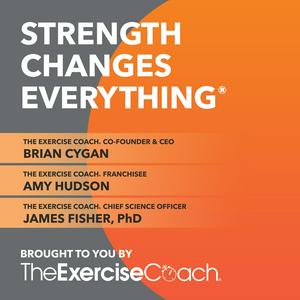Why Most People Fail in the Gym (And How Supervision With a Personal Trainer Can Help)
Amy Hudson and Dr. James Fisher dive deep into the science of supervised workouts, sharing research on the benefits of guided workouts. They explore the key differences between supervised and unsupervised training, why many people struggle to train effectively on their own, and how coaching impacts technique, effort, safety, and motivation. Tune in to hear why men and women respond differently to coaching, ways technology is changing the way we work out, and why a trainer might be the secret weapon you didn’t know you needed. Amy and Dr. Fisher start by explaining the difference between supervised and unsupervised training. What is a supervised workout? Dr. Fisher defines it as training with real-time feedback from a qualified professional to enhance technique, effort, and safety. Dr. Fisher explains why most strength training studies don’t reflect real-world results. He reveals that most studies are supervised, testing whether training works under ideal conditions, not whether people can sustain them in daily life. Amy highlights the overwhelming evidence supporting strength training. Unfortunately, many people avoid it due to its perceived complexity and difficulty. Amy reveals the key reason most people struggle to get started with strength training: uncertainty—people walk into the gym unsure of what to do, which leads to frustration or avoidance. Dr. Fisher covers supervised vs. unsupervised training--and why coaching makes a huge difference. How supervised strength training consistently leads to better results in technique, effort, safety, and adherence. What makes personal training invaluable? Effort: Pushing beyond your comfort zone. Trainers help clients train at the right intensity, ensuring they work hard enough to see real results. Motivation: Having a coach boosts engagement, making training feel less like a chore and more like a rewarding experience. Safety: Dr. Fisher emphasizes that people who train alone are far more likely to get injured compared to those with professional supervision. Accountability: Working with a trainer creates external accountability, making it far more likely that people show up and stay consistent. Smart programming: Coaches tailor workout plans to evolve over time, adjusting intensity, resistance, and exercise selection for steady improvement. Technique: A coach ensures correct form, preventing injuries and maximizing the effectiveness of each exercise. How technology is transforming strength training. Dr. Fisher and Amy discuss the role of exerbotic machines and augmented feedback in optimizing workouts and improving results. Learn why different clients need different coaching approaches. Amy explains that beginners need more focus on technique, while advanced clients benefit from coaching on effort, mindset, and fine-tuning their performance. Dr. Fisher explains that while positive feedback is key, research shows that well-timed negative feedback—urging someone to push harder—can drive significant progress. The trainer-client relationship is more than just fitness. Dr. Fisher reveals that many people compare their relationship with a trainer to that of a doctor or dentist, highlighting the trust and accountability involved. Men vs. women: How supervision affects training differently. Dr. Fisher discusses a study showing that men feel more confident maintaining high effort and safety, while women tend to benefit more from supervision. Why female clients push harder with a coach. Amy highlights that women often maximize their effort in strength training when working under professional guidance. If you struggle to give your best effort in workouts, Amy encourages you to check out The Exercise Coach and work with a trainer for faster, better results. Mentioned in This Episode: The Exercise Coach - Get 2 Free Sessions! Submit your questions at StrengthChangesEverything.com This podcast and blog are provided to you for entertainment and informational purposes only. By accessing either, you agree that neither constitute medical advice nor should they be substituted for professional medical advice or care. Use of this podcast or blog to treat any medical condition is strictly prohibited. Consult your physician for any medical condition you may be having. In no event will any podcast or blog hosts, guests, or contributors, Exercise Coach USA, LLC, Gymbot LLC, any subsidiaries or affiliates of same, or any of their respective directors, officers, employees, or agents, be responsible for any injury, loss, or damage to you or others due to any podcast or blog content.
